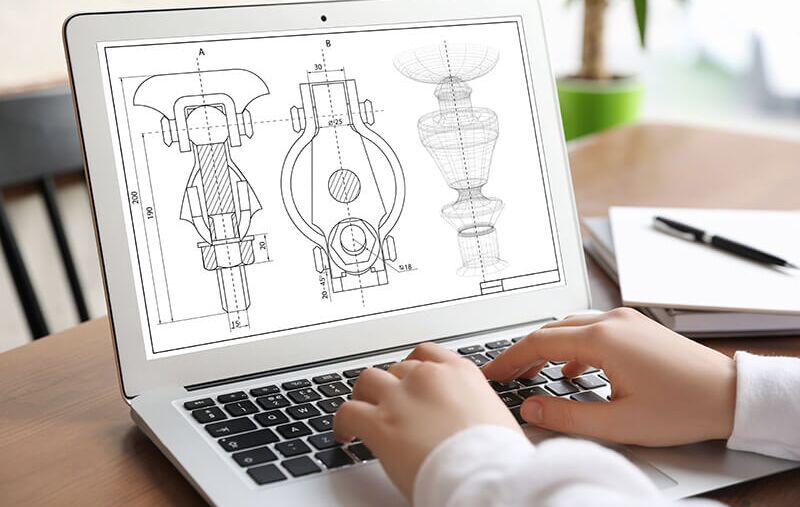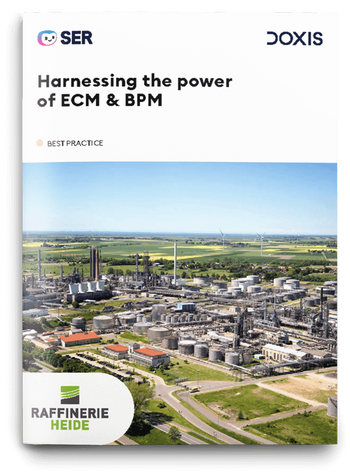SER Blog Customer Stories & Use Cases
Technical documentation
Authoring, archiving, retention periods and more
Technical documentation is an umbrella concept for all the documents that manufacturers provide about a specific product for information purposes. In this regard, technical documentation provides information, for example, about how companies commission, service, clean, or repair technical equipment or a machine. It is also linked to legal standards and requirements. Technical equipment and machines are only ready for operation when the technical documentation is complete.
In this article, we show you how to create, archive, and store technical documents, and we look at software designed to help you comply with important standards and processes.

What is technical documentation?
Technical documentation is a collection of documents provided by a manufacturer for a technical product, system or process. Product documentation is a synonym for technical documentation. It contains all the information that users and other product stakeholders need in order to use a technical product safely and to assess risks properly – from product design through manufacture and operation.
Organization of technical documentation
Technical documentation is not a loose collection of documents. All technically relevant usage information is organized and compiled for the respective target group using consistent and accurate terminology. The terminology standardizes the requirements for technical documentation across all documents – it defines the documentation structure, the document layout, and editorial processes.
In other words: Technical documentation follows a uniform standard that is clear, understandable, consistent, and translatable.
Types of technical documentation
In general, technical documentation is divided into internal and external types.
Internal technical documentation
Through internal technical documentation, manufacturers meet the legal requirement to provide documentation. It begins with the initial development of a product and ends after the retention period. Internally, companies document all knowledge related to a product.
For example, internal technical documentation consists of documents that are relevant for the (continued) development or testing of a product. It captures all versions of a product throughout its product life cycle or instructions on how IT resolves known technical issues.
External technical documentation
External technical documentation includes all information that a manufacturer provides to the outside world. For example, the manufacturer provides end users with operating or installation instructions, maintenance, and repair instructions, as well as technical specifications and data sheets.
Components of technical documentation
What technical documents comprise the documentation depends on the product, system, or process that you want to document. The forms of documentation are very different. Depending on the content, an image, text, or drawing is ideal for documenting it. It is also important that the format selected communicates the content clearly and accurately.
Contents of technical documentation can include, for example:
-
Introduction and product description
-
Instructions for use and installation
-
Safety information and warnings
-
Technical drawings and diagrams
-
Risk assessments
-
Logs and test reports
-
Emergency manual and online help
-
Standards used
Preparation of technical documentation
A technical writer is usually responsible for creating the technical documentation. They proceed on a step-by-step basis.
Needs and requirements analysis
How a technical writer creates the documents is determined by legal standards, by the requirements of stakeholders such as customers and users, and by needs. With needs, we mean the documentation that is needed to provide complete and understandable information about the product.
For example, an assembly instruction for a piece of furniture is needed to assemble it. In contrast, complex installation and maintenance instructions are a requirement for similarly complex industrial equipment. Based on all the needs, the technical writer then plans the content, i.e. which documents belong in the technical documentation.
Research and implementation
Before a technical writer begins writing, they first research the content. They get information from a range of sources: developers, engineers, or product managers support the editorial process – either with technical input or by helping to validate the content.
For example, the developer provides input for programming a software process, which the technical writer then prepares textually and visually with a graphic designer. The developer then checks again whether the information is presented properly.
Companies also like to have end users review information development in terms of its usability. This helps companies to ensure that the people who ultimately work with the technical documentation understand it.
Publication and updates
Once the work result has been validated, executives such as product managers review the technical documents again. If all the information is correct, they approve the technical documentation, and it is published.
Technical documentation is rarely a static work. Technical writers always add additional documentation as soon as something changes in the information product – whether a new software update, a detected error, or an add-on.
Compliance and legal aspects
Technical documentation is mandatory for manufacturers. It also protects against liability risks that may arise in relation to a product. Technical documentation is clearly an integral part of a product and therefore also part of the product liability.
Expressed differently, technical documentation is the proof that all legal requirements for use have been met by the manufacturer. For this reason, a technical product – such as a device or software-based medical product – may only appear on the market once the technical documentation is available. It is the basis for ensuring that a product is safe and meets all the legal requirements.

Raffinerie Heide: Flexible processes & secure documentation
How Raffinerie Heide uses Doxis to manage information and processes, stay demonstrably compliant and improve business process efficiency.
Read nowComplying with legal regulations
In the European Union, for example, all products marketed have to have a CE mark, if the relevant directive requires it. This is the case, for example, with the EC Machinery Directive.
In general, the CE mark requirement applies to those products that fall within the scope of the European directive on health, safety, electromagnetic compatibility, and environmental protection. For these products, a manufacturer is obliged to comply with the required protection objectives and to carry out a risk analysis. A company may only issue a declaration of conformity when the protection objectives have been met and the risks comply with the harmonized EU standards.
Liability issues and product liability
With the EU/EC declaration of conformity, a company confirms that the product complies with the legal standards and directives. In most cases this is the manufacturer itself, the importer, or a dealer. The person who brings the product onto the market is liable.
Claims for damages or other liability claims always arise when product safety-specific requirements or contractual items are not met.
Important standards
In order to ensure that technical documents are understandable and information is recorded in a legally compliant manner, relevant standards have to be observed. The best known standards for technical documentation are:
-
IEC/IEEE 82079-1: provides information on the general requirements for technical documentation.
-
EN 82079-1: describes what you need to consider when creating user manuals.
-
ANSI Z535.6: regulates how you should present warnings and safety notices.
-
EN ISO 17100: explains what you need to pay attention to when translating technical documentation and gives tips on translation software.
Retention periods and long-term archiving
The subject of technical documentation is not only the content of the documents – each individual document is also part of the technical documentation. In technical documentation, companies have to record how and where they manage and archive the documents.
Because technical documents are part of long-term archiving. Typical retention periods for long-term archives are between six and ten years. The retention period for technical documentation is ten years. During this time, companies keep the technical documentation in an archive.
When archiving keep in mind the following: It has to be ensured at all times that the documents are stored in an audit-proof manner and that they can be accessed quickly.
Challenges for technical documentation
Technical documentation projects are complex. They govern legal aspects, document product processes, provide information for users and operators, and serve as the basis for a product to be allowed on the market. At the same time, technical documentation continues to develop with time. In contrast to the past, a product is no longer created one time and then continues to exist as-is. Products develop and so does the documentation.
The internationalization of business is also challenging for technical documentation: creating documents in one language is not enough. Technical writers translate documentation into all the languages of the countries where a product is sold.
These are the challenges of technical documentation at a glance:
-
Always complying with changing legal requirements
-
Translating documents into all languages
-
Keeping technical documentation up to date with the product
-
Creating user-friendly content
-
Archiving items in the long-term archive in an audit-proof manner for at least ten years
Archiving technical documents in Doxis
Standardized processes can help companies to meet the related challenges. Document management, in particular, takes up a lot of time in companies as part of technical documentation. Efficient processes in a document management system (DMS) can automate and accelerate work activities and archiving processes.
What is Doxis?
Doxis is a content services platform that integrates documents, business processes, collaboration, and more. As a DMS, Doxis manages information across systems. For example, Doxis enhances your product information management system (PIM) by archiving product-relevant documents.
Doxis also has integrations that connect both software programs without any media disruption. Doxis works in the background when you use your PIM as usual and speeds up processes.
Archiving technical documents step-by-step in Doxis
Hey Doxi, how does Doxis work as software for technical documentation?
- Organizes your documents: Doxis stores documents in the relevant product file and in context.
-
Makes your processes transparent: Versioning ensures that all older versions are retained whenever you update your documents.
-
Provides understandable folder structures: Preconfigured folder structures show in which languages the technical documents are available.
-
Works for you: Doxis triggers workflows – for example, when translations are missing.
-
Provides faster access: All authorized persons can access documents quickly and easily. This speeds up searches and responses to stakeholders such as customers.
-
Archives for the long term: Doxis stores information regardless of the format, enabling long-term archiving.: Using a modern, standardized DMS ensures that you follow compliance standards.
Seamless technical documentation with Doxis
Technical documentation captures everything that makes a product from a technical perspective, from design to operation. With operating instructions, assembly instructions, other usage information, and safety information, companies make it clear internally and externally that they have met the requirements for use.
Technical documentation thus provides a legal basis for marketing the product as well as an information product that fully informs everyone who comes into contact with the product. With Doxis you can manage your technical documents securely and efficiently – from development to deletion after the retention period has expired.
FAQs about technical documentation
The latest digitization trends, laws and guidelines, and helpful tips straight to your inbox: Subscribe to our newsletter.
How can we help you?
+49 (0) 30 498582-0Your message has reached us!
We appreciate your interest and will get back to you shortly.




